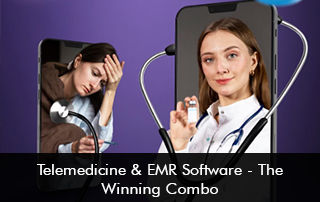The healthcare industry has undergone a massive transformation in recent years, driven by technological advancements and the increasing demand for accessible, efficient, and patient-centered care. Two of the most impactful innovations in this space are telemedicine and EMR software.
When combined, telemedicine and EMR systems create a powerful synergy that enhances patient care, streamlines workflows, and improves overall healthcare delivery. In this blog, we’ll explore how these technologies work together, their benefits, challenges, and why they are the ultimate winning combination for modern healthcare.
1. What is Telemedicine?
Telemedicine refers to the remote delivery of healthcare services using telecommunications technology. It allows patients to consult with doctors via video calls, phone calls, or messaging platforms, eliminating the need for in-person visits in many cases.
Key Applications of Telemedicine:
-
Virtual Consultations – Patients can receive medical advice without visiting a clinic.
-
Remote Monitoring – Chronic conditions can be managed through wearable devices and IoT-enabled tools.
-
Mental Health Support – Teletherapy and online counseling have become increasingly popular.
-
Second Opinions – Specialists can review cases remotely, improving diagnosis accuracy.
2. What is EMR Software?
Electronic Medical Records (EMR) software digitizes patient health information, replacing traditional paper records. EMRs store medical histories, lab results, prescriptions, and treatment plans in a centralized, secure database.
Key Features of EMR Software:
-
Patient Records Management – Easy access to medical histories, allergies, and past treatments.
-
E-Prescriptions – Doctors can send prescriptions directly to pharmacies.
-
Lab Integration – Test results are automatically updated in patient records.
-
Billing & Scheduling – Streamlines administrative tasks and reduces errors.
3. How Telemedicine & EMR Software Work Together
Integrating telemedicine with EMR systems creates a seamless healthcare experience for both providers and patients. Here’s how they complement each other:
Enhanced Patient Care Coordination
-
Doctors can access a patient’s complete medical history during a virtual visit, ensuring informed decision-making.
-
Specialists can collaborate more efficiently by reviewing EMR data before teleconsultations.
Streamlined Workflows
-
Telemedicine encounters are automatically logged into the EMR, reducing manual data entry.
-
Automated reminders and follow-ups can be scheduled based on EMR records.
Improved Chronic Disease Management
-
Remote patient monitoring data (e.g., glucose levels, blood pressure) can be directly fed into EMRs.
-
Physicians can track trends and adjust treatment plans in real-time.
Better Patient Engagement
-
Patients can access their health records via patient portals linked to EMRs.
-
Secure messaging within telemedicine platforms ensures continuous communication.
4. Key Benefits of Combining Telemedicine & EMR Software
Increased Accessibility to Healthcare
-
Rural and underserved populations can receive quality care without traveling long distances.
-
Elderly and mobility-challenged patients benefit from remote consultations.
Cost Savings for Providers & Patients
-
Reduces overhead costs associated with in-person visits.
-
Minimizes no-shows and last-minute cancellations.
Higher Efficiency & Productivity
-
Eliminates redundant paperwork and manual record-keeping.
-
Enables faster decision-making with real-time data access.
Improved Data Accuracy & EMR Software Security
-
Reduces errors caused by illegible handwriting or misplaced files.
-
HIPAA-compliant EMRs ensure patient data remains secure.
Better Population Health Management
-
Aggregated EMR data helps identify health trends and improve preventive care strategies.
-
Public health agencies can track outbreaks more effectively.
5. Challenges & How to Overcome Them
While the integration of telemedicine and EMR software offers numerous advantages, there are some challenges:
Interoperability Issues
-
Not all EMR systems seamlessly integrate with telemedicine platforms.
-
Solution: Choose HIPAA-compliant telemedicine solutions with API integrations for popular EMRs like Epic, Cerner, or NextGen.
Patient & Provider Adoption
-
Some patients (especially older adults) may struggle with technology.
-
Providers may resist transitioning from traditional workflows.
-
Solution: Offer training sessions, user-friendly interfaces, and incentives for adoption.
EMR Software Data Privacy Concerns
-
Cybersecurity threats can compromise sensitive patient data.
-
Solution: Implement end-to-end encryption, multi-factor authentication, and regular security audits.
Regulatory & Reimbursement Hurdles
-
Telemedicine reimbursement policies vary by region and insurance provider.
-
Solution: Stay updated on telehealth laws and advocate for standardized reimbursement models.
6. Future Trends in Telemedicine & EMR Software Integration
The future of healthcare lies in deeper integration between telemedicine and EMR systems. Emerging trends include:
AI-Powered Virtual Assistants
-
AI chatbots can triage patients before consultations and update EMRs automatically.
Blockchain for Secure Health Records
-
Decentralized EMRs could enhance data security and patient control over records.
IoT & Wearable Integration
-
Smart devices will feed real-time health data directly into EMRs for proactive care.
Predictive EMR Software Analytics for Personalized Care
-
Machine learning algorithms will analyze EMR data to predict health risks and recommend preventive measures.
A Winning Combo for the Future of Healthcare
Telemedicine and EMR software are no longer optional but essential components of a modern, efficient, and patient-centric healthcare system. Together, they bridge gaps in accessibility, improve care coordination, reduce costs, and enhance overall patient outcomes.
Healthcare providers who embrace this winning combination will stay ahead of the curve and deliver superior care in an increasingly digital world. The future of medicine is here, and it’s powered by the seamless integration of telemedicine and EMR technology.
Are you ready to leverage this powerful duo in your practice? The time to act is now!








